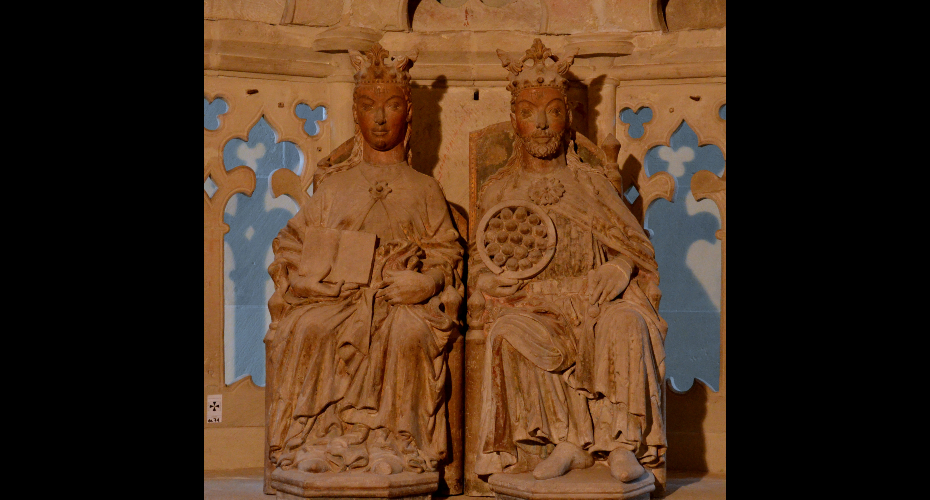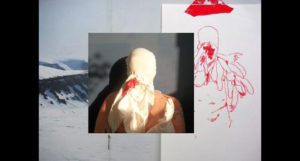Historical analysis helps to re-date a King’s tribute to his late English Queen

Magdeburg Cathedral statues of Otto and Edith. Picture by Romke Hoekstra,via Wikimedia Commons
A historical document written by one of early medieval Europe’s most important rulers to his beloved English queen has been re-dated following analysis by an Exeter historian.
The testimony of King Otto I of Germany, in which he donates a large estate to his church in Fallersleben for the “salvation of the soul” of his Queen Edith, has, for more than a century been thought to be dated A.D. 942.
But this date and the reference to his queen’s soul has been the subject of historical speculation because Queen Edith – daughter of King Edward the Elder, and granddaughter of Alfred the Great – was still alive at that time.
In the same document, King Otto, who would later become the founder of the Holy Roman Empire, also dedicated the offering of land to the “well-being of his son”, Liudolf, clearly differentiating his family through his choice of two well-recognised expressions.
But now a historian in the University of Exeter’s Department of Archaeology and History has studied the original document and found evidence that it was written in A.D.950, four years after the sudden death of Queen Edith.
Professor Levi Roach, an expert in Western European history of the Middle Ages, has been researching a corpus of documents relating to King Otto, including this one held by the State Archives of Saxony-Anhalt.
“Dating documents in the Middle Ages presents challenges to historians because they were not yet done according to the Gregorian calendar as is widely used today,” said Professor Roach. “When I began to examine this piece, I had a ‘Eureka moment’ because within minutes, it was clear that modern scholars had mis-dated it, and it was, in effect, a tribute to the king’s late wife and their surviving son.”

The document, one of more than 540 from Germany that Professor Roach is studying and editing, would have been drafted by a high-level notary during Otto’s rule, and bears a purported date of 966. In his analysis, published in the German journal Monumenta Germaniae Historica, Professor Roach said several discrepancies with this date – including the fact that Otto would have been the emperor at this time, and not a king – had initially convinced many early historians that it was a forgery. That was until the great Prussian scholar Theodor Sickel re-examined it and dated it to 942.
“It is by no means a standard royal document,” says Professor Roach. “The passage on the salvation of souls, with its strong emphasis on caring for the ruler’s first wife and their son Liudolf, is clearly out of the ordinary and was already noticed by 20th century historians, who thought that it might hint at some form of undocumented crisis or illness, such as Edith suffering a miscarriage.”
Edith was a member of the House of Wessex and married Otto – the son and heir to King Henry the Fowler – in 929/30 to seal an alliance between the two Saxon kingdoms. When Otto succeeded Henry to the throne six years later, Edith was anointed queen and they had two children, before she passed away suddenly around 946. And despite remarrying, and the succession line changing, when Otto himself died, he was buried next to Edith at Magdeburg Cathedral.
In studying the document, Professor Roach found several typographic and punctuation consistencies with another that had been written by the same notary in Magdeburg, and which also bears the year of 966. However, this latter document bears a secondary date (known as a regnal date) relating to the years of the king’s reign, which pinpoints it to 950. It is almost inconceivable, Professor Roach concluded, that one notary could have made the exact same mistake eight years apart; and therefore, in all likelihood, he drafted them at the same time – in the year 950.
“First and foremost, this redating deepens our understanding of this important but difficult to interpret document, which can now be counted among a series issued after 946 for the eternal memory of Edith,” Professor Roach adds. “It also underlines how important it is to ask fundamental questions about the origins of our documentary sources and not to tacitly accept previously valid knowledge.
“Above all, it provides further insight into the relationship between Otto and Edith. Although they were married for a much shorter period than Otto was with his second wife, it is next to Edith that he would be buried. This was clearly a love that lasted through the ages.”



